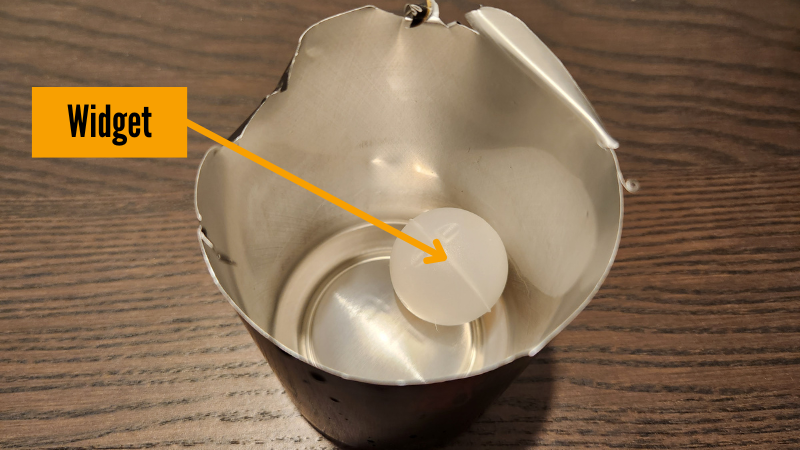Guinness Widget Explained – Why Is There A Plastic Ball In Guinness Beer?
If you’ve ever enjoyed a Guinness at home, you have probably noticed the plastic ball inside your can. If you’re wondering what this plastic ball is and how it works, you’ve come to the right place! This plastic ball, known as a ‘widget’, is essential to creating the unique mouthfeel and creaminess of Guinness draught.
The widget in Guinness is infused with nitrogen. When you open the can, the nitrogen is released, and this helps to create a creamy mouthfeel and a foamy head. In short, there is a widget in your Guinness can so that the Guinness you pour from the can is just like the draught Guinness you would get from a keg.
Obviously, there is a lot more to this clever little invention. Keep reading to learn more about this widget, why Guinness uses nitrogen instead of C02 to carbonate its beer, and some valuable tips on how to pour Guinness properly from a can.
The Evolution and Significance of the Guinness Widget
The widget, a seemingly simple innovation, plays a crucial role in delivering the iconic taste and texture of Guinness Draught. Its primary function is to carbonate the beer with nitrogen, which gives Guinness its renowned mouthfeel and creamy head. Nitrogen not only ensures a creamier texture but also provides a unique pour that sets Guinness apart.
In 1951, Michael Ash joined the Guinness team and brought with him a vision: to serve Guinness in draught form with a distinctive feel. Ash’s innovative approach led him to blend 75% nitrogen and 25% CO2 for carbonation.
This blend was not just about texture; it also brought about the celebrated “surge and settle” effect that we associate with a freshly poured pint of Guinness. When poured, the beer is effervescent, producing a cascade of bubbles, which, after about two minutes, settle to form the beer’s characteristic head.
The draught experience was a hit in pubs and bars, and naturally, Guinness enthusiasts wanted to replicate this experience at home. Enter the widget. This plastic ball, filled with nitrogen, was the brainchild of the Guinness team, designed to bring the draught experience to canned beer.
While the widget was patented in 1968, it wasn’t until 1989 that it made its debut in cans. The initial design, a flat sphere resting at the can’s bottom, faced some challenges. While it flawlessly carbonated the beer when cold, it caused the can to burst open when warm. Recognizing the issue, Guinness promptly introduced a redesigned widget, which is still in use today and ensures a perfect pour every time.
How Does The Guinness Widget Work?
While it might look like just a small plastic ball, the Guinness widget plays a big role. Here’s how this little piece of plastic changes how your Guinness pours and tastes.
The widget is shaped like a tiny ping-pong ball and has a small hole in it. When the beer is put into cans, pressurized nitrogen is added. Some of this nitrogen goes into the widget through the hole. Then, the whole can is pressurized before being sent to stores and pubs.

When you open the can, the pressure inside drops to match the air around you. But, the widget keeps its pressure. This makes the nitrogen rush out, giving you the famous “surge and settle” effect and that creamy head, just like pouring from a tap.
How To Pour Guinness From A Can Perfectly Every Time
To get the best out of your Guinness can, pouring it correctly is essential. Here are two recommended methods of pouring Guinness from a can: The ‘classic’ way and the ‘hard’ pour. Before we look at these two methods, a quick tip: don’t shake the can! You might think it’ll give you more bubbles, but it’ll actually make your beer go flat.

Method 1: The Classic Pour
- Start with a clean pint glass.
- Hold the glass at a 45-degree angle.
- Begin pouring the beer slowly down the side of the glass.
- As the glass fills up, straighten it until it’s completely upright.
- Let the beer settle for about 2 minutes to get that perfect creamy top.
Method 2: The Hard Pour
- Open your can and quickly place a dry pint glass over the top.
- In one swift motion, flip them so the glass is now at the bottom.
- Slowly lift the can, letting the beer flow out.
- Like the classic pour, give it a few minutes to settle before taking your first sip.
Which Other Beers Use A Widget?
Guinness might be the most famous name associated with the widget, but it’s not the only brewer to use this clever little device. Here are some common beers that use a widget:
- Young’s Double Chocolate Stout: A rich and indulgent stout that’s elevated by the widget’s nitrogen release, creating a velvety texture that complements its chocolaty notes.
- Boddingtons Pub Ale: Known for its golden color, this English pub ale uses the widget to ensure its signature creamy head stays intact from the can to your glass.
- Old Speckled Hen: This English ale has a distinctive malty taste. The widget ensures a consistent pour, helping to highlight its unique flavors.
- Murphy’s Stout: Often compared to Guinness, Murphy’s has its own take on the classic Irish stout. Its widget helps create a dense, creamy head that stout enthusiasts love.
Wrapping Up
The widget in Guinness cans (the small plastic ball) is the key to getting that authentic Guinness draught creaminess and mouthfeel from a can. A marvel of modern brewing, this tiny plastic ball transforms a can of beer into a pub-quality pint. While Guinness may have popularized the widget, many other brewers have embraced its magic, proving its influence in the beer industry.

